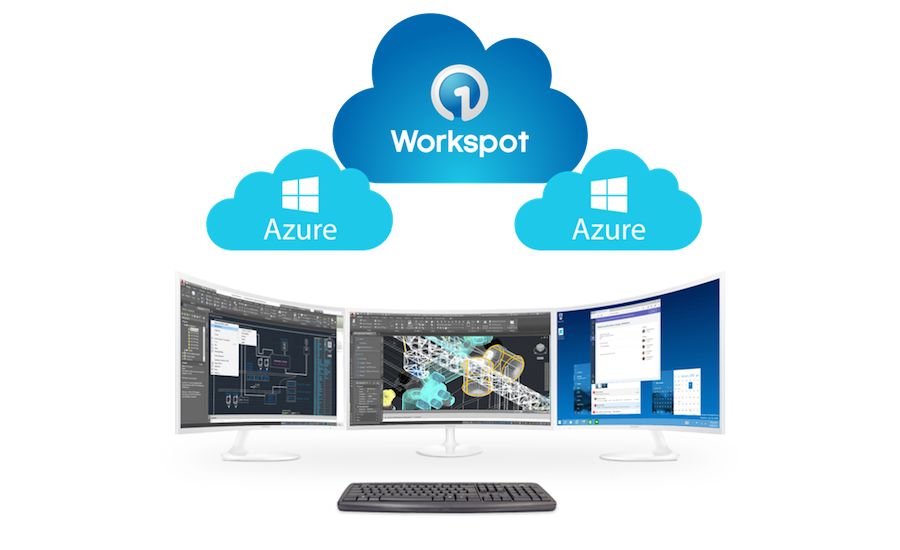Disruption to the industry from the coronavirus has mostly been visible on construction jobsites, with workers furloughed and deliveries delayed or cancelled. But there are similar interruptions happening at engineering and design firms—and not all companies are able to handle the forced move to a virtual office.
[For ENR’s latest coverage of the impacts of the COVID-19 pandemic, click here]
For many, key project files sit inaccessible on isolated servers. Those who have successfully migrated to the cloud say it's not a move that can happen quickly, but there are things that companies can start doing now.
For the firms that made the investment, the current virus pandemic has been an unplanned stress test of their IT infrastructure.
“It’s actually working out better than I would have expected,” says Andy Knauf, CIO and vice president at Mead & Hunt. The Middleton, Wis.-based firm has 38 offices scattered across the country. Knauf was finishing up a migration of all the company’s data and workstations to the cloud when the pandemic hit.
“I never thought I’d have to do this,” he says. “ When I think of all the things we did to prepare for something like this—every one of my people is able to work at the same level as in the office. If we stopped working for a day, it’ll cost us a little over a half a million dollars a day from where we’re sitting,” says Knauf.
Knauf had experimented with several cloud-based systems over the years, but eventually settled on Microsoft’s Azure cloud with Workspot. This system not only hosts the company’s data, but it also allows employees to log in to their normal work environment from any internet-connected computer to run the full suite of design software they need. All the computing power is done in the cloud, so even modest computers can navigate and work in massive BIM files.
While there were some hiccups as employees logged on from home for the first time, Knauf's team has resolved all problems, and he says the firm is back to business as usual. Even workers who thought their home internet wasn't good enough to work virtually were able to keep up. “You don’t need to have that much bandwidth to run Workspot, so even people in rural areas don’t have to have much of an internet connection to keep working," Knauf says.
Roughly 80% of the design and engineering work that Mead & Hunt performs is for public agencies, so the deadlines haven’t stopped even as the pandemic response slows private construction. “The DOTs and everything, they expect us to keep pushing through,” says Knauf. “They expect all that engineering to be done; they’ve been calling us and expect it to be finished on time.”
Knauf, however, has been fielding questions from Mead & Hunt’s government clients who need tips on working remotely. “We’re trying to help as many people as we can but it’s been hit or miss, especially DOTs. These government agencies are not set up like us; they can barely run Skype in their environment,” he says.
Design firms aren’t the only ones benefiting from working in the cloud. Mechanical, electrical and plumbing (MEP) specialty contractor Southland Industries had been working on shifting all of its design detailing and BIM work to Microsoft Azure and Workspot as well, and has decided to accelerate those plans because of the pandemic. “Right now we still have some on-premises tape backups, but my plan is to have everything migrated to the cloud by the end of December 2020," says Israel Sumano, senior director of infrastructure services at Southland Industries.
"We finished up migrating our Mountain-West region last December, only the Mid-Atlantic is left,” says Sumano. “ It has definitely put our company in a good position. Other MEP subcontractors are struggling right now.” Some employees still must conduct limited on-premise work, including with the enterprise resource planning (ERP) systems used by project partners, but Sumano says the company is ready to keep going on projects.
Shift to Cloud Infrastructure Takes Time, Not an Instant Lifeline in a Crisis
Scattered success stories from the firms that have gone to the cloud are cold comfort to those trying to cobble something together during a pandemic.
“I’ve gotten called this week by presidents and CEOs of different firms saying that they've got nothing: they weren't prepared for this,” says Knauf. “They are where we were eight years ago.”
Both Knauf and Sumano say the planning and implementation of their cloud migration took many months, and required a transition period to maintain business continuity.
“I am willing to help ... push them in the right direction,” adds Knauf. “But some companies, however long this lasts, might not be around in three months.” Knauf says he knows of at least one company based in Pennsylvania that can’t operate at all because the total stop-work order has them locked out of their offices where all their data is sitting on servers.
While getting a full Azure setup with Workspot licenses might be a bit much to start with, Knauf says companies should definitely begin investing in cloud backups so they don’t get locked out of their own data. Companies such as Panzura offer cloud storage, and prior to working with Microsoft, Knauf had some initial success with the Panzura cloud in mirroring the company's data to get it off of on-site servers.
But even spinning up a deployment of 20 terabytes of data for 400 workers on Panzura took Mead & Hunt six months of work. Today the company has 125 TB of data and more than 30 offices worth of employees on Azure and Workspot, after years of work.
One company called Knauf asking what to do to manage their 60 offices and 400 TB of data, with very little cloud infrastructure in place. “I said ‘you gotta get some data up there, but it’s going to be a long process,'" Knauf says.
Southland’s Sumano agrees the sooner companies start shifting to the cloud the better it will be in the long run. “Make sure you put all your data where it belongs. If you do this you can’t hold onto the on-premises resources—you need to let them go.”
Knauf notes the situation is not all hopeless for firms with limited cloud-based IT infrastructure, particularly if they are willing to triage and focus on getting a few critical projects in the cloud first. “You could get a mini infrastructure up in a week or so, take a couple projects you need, get a few Workspot licenses, go out and get 20 TB blobs of Azure storage, you could deploy there and get working. Just get started on it, throw some money at it and get done what has to to get done.”
Sumano says the time is past to stop contemplating. “When I first told [our company leadership] we were going entirely to the cloud it was a deer-in-the-headlights response, but we did it. Go out there and get it,” says Sumano.






Post a comment to this article
Report Abusive Comment